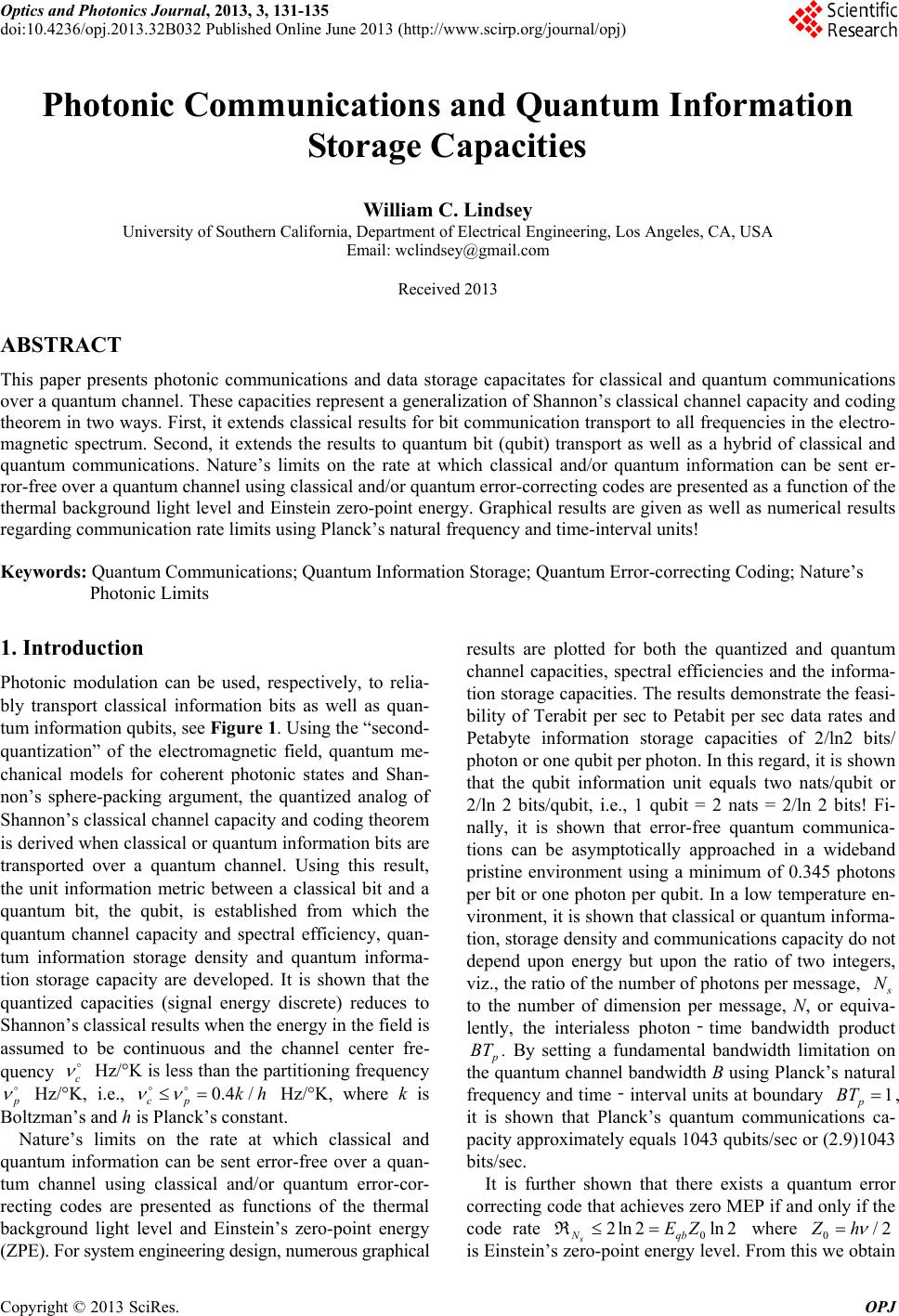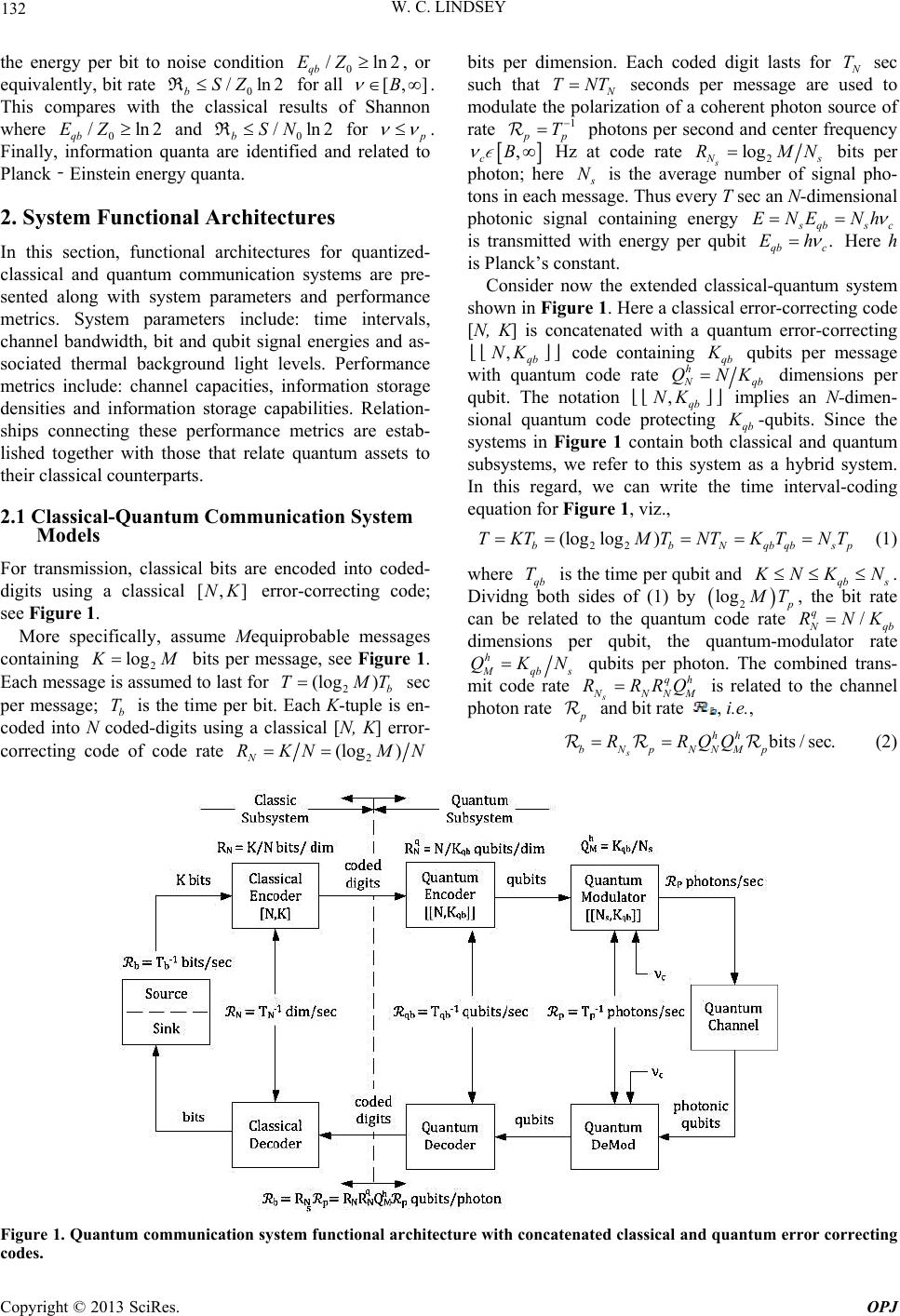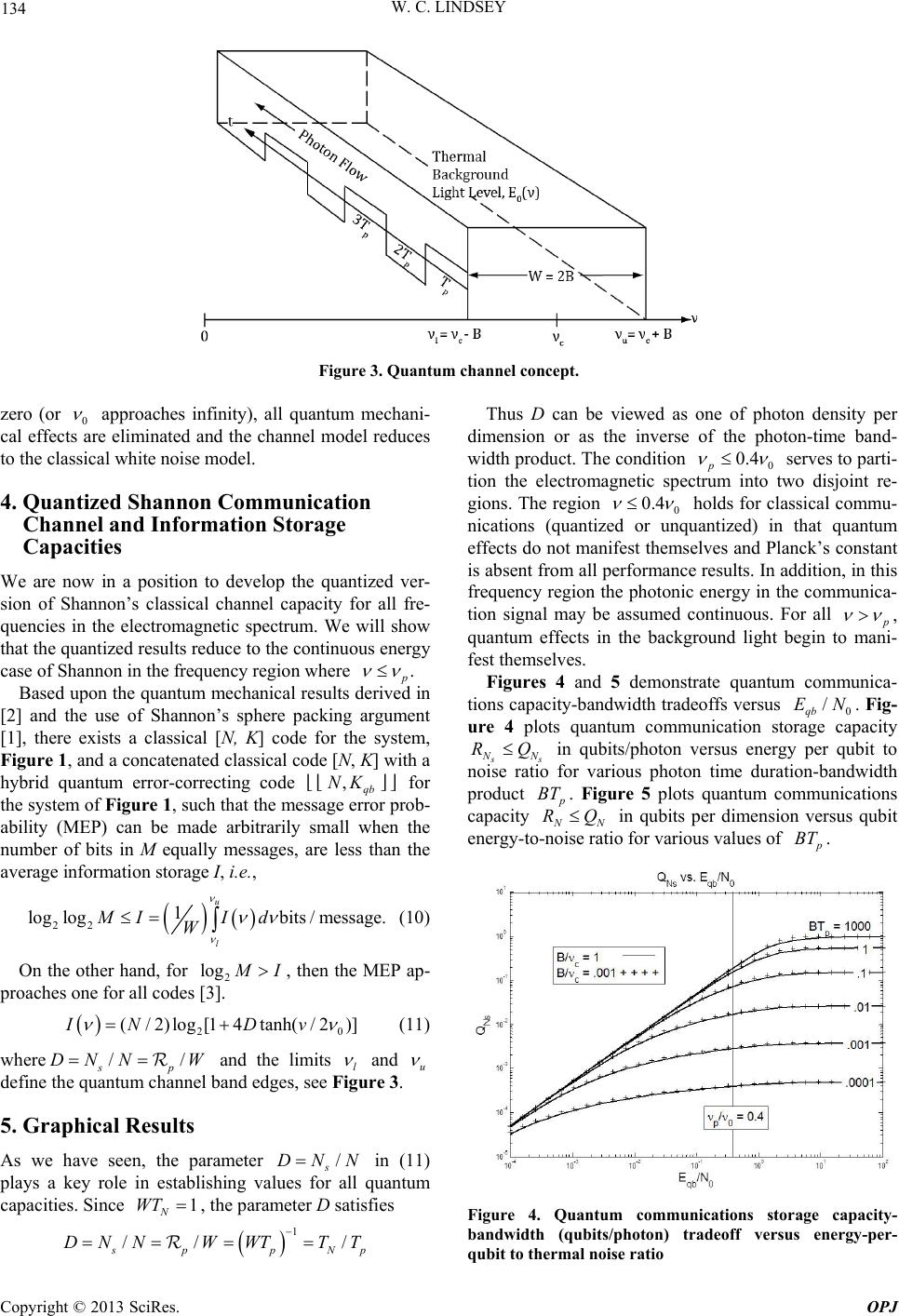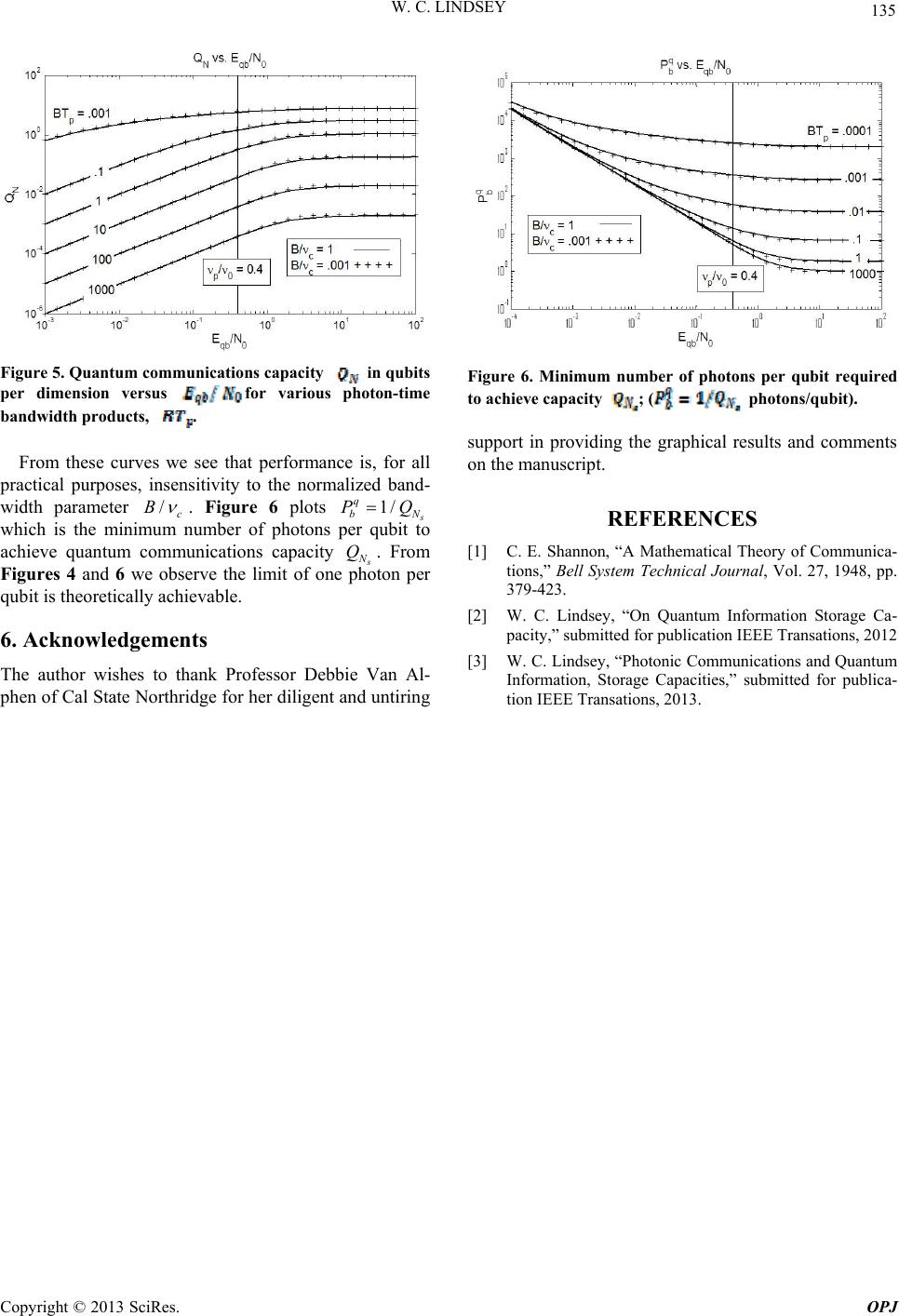Paper Menu >>
Journal Menu >>
 Optics and Photonics Journal, 2013, 3, 131-135 doi:10.4236/opj.2013.32B032 Published Online June 2013 (http://www.scirp.org/journal/opj) Photonic Communications and Quantum Information Storage Capacities William C. Lindsey University of Southern California, Department of Electrical Engineering, Los Angeles, CA, USA Email: wclindsey@gmail.com Received 2013 ABSTRACT This paper presents photonic communications and data storage capacitates for classical and quantum communications over a quantum chan nel. These capacities repr esent a generalization of Sh annon’s classical chan nel cap acity and co ding theorem in two ways. First, it extends classical results for bit communicatio n transport to all frequencies in the electro- magnetic spectrum. Second, it extends the results to quantum bit (qubit) transport as well as a hybrid of classical and quantum communications. Nature’s limits on the rate at which classical and/or quantum information can be sent er- ror-free over a quantum channel using classical and/or quantum error-correcting codes are presented as a function of the thermal background light level and Einstein zero-point energy. Graphical results are given as well as numerical results regarding communication rate limits using Planck’s natural frequency and time-interval units! Keywords: Quantum Communications; Quantum Information Storage; Quantum Error-correcting Coding; Nature’s Photonic Limits 1. Introduction Photonic modulation can be used, respectively, to relia- bly transport classical information bits as well as quan- tum information qubits, see Figure 1. Using the “second- quantization” of the electromagnetic field, quantum me- chanical models for coherent photonic states and Shan- non’s sphere-packing argument, the quantized analog of Shannon’s classical channel capacity and coding theorem is derived when classical or quantum information bits are transported over a quantum channel. Using this result, the unit information metric between a classical bit and a quantum bit, the qubit, is established from which the quantum channel capacity and spectral efficiency, quan- tum information storage density and quantum informa- tion storage capacity are developed. It is shown that the quantized capacities (signal energy discrete) reduces to Shannon’s classical results when the energy in the field is assumed to be continuous and the channel center fre- quency c Hz/°K is less than the partitioning frequency p Hz/°K, i.e., Hz/°K, where k is Boltzman’s and h is Planck’s consta nt. 0.4 / cp kh Nature’s limits on the rate at which classical and quantum information can be sent error-free over a quan- tum channel using classical and/or quantum error-cor- recting codes are presented as functions of the thermal background light level and Einstein’s zero-point energy (ZPE). For system engineering design, num e rous graphical results are plotted for both the quantized and quantum channel capacities, spectral efficiencies and the informa- tion storage capacities. Th e results demonstrate the feasi- bility of Terabit per sec to Petabit per sec data rates and Petabyte information storage capacities of 2/ln2 bits/ photon or one qubit per photon. In this regard, it is shown that the qubit information unit equals two nats/qubit or 2/ln 2 bits/qubit, i.e., 1 qubit = 2 nats = 2/ln 2 bits! Fi- nally, it is shown that error-free quantum communica- tions can be asymptotically approached in a wideband pristine environment using a minimum of 0.345 photons per bit or one photon per qubit. In a low temperature en- vironment, it is shown that classical or quantum informa- tion, storage density and communications capacity do not depend upon energy but upon the ratio of two integers, viz., the ratio of the number of photons per message, s N to the number of dimension per message, N, or equiva- lently, the interialess photon‐time bandwidth product p BT . By setting a fundamental bandwidth limitation on the quantum channel bandwid th B using Planck’s natural frequency and time‐interval units at boundary p1BT , it is shown that Planck’s quantum communications ca- pacity approximately equ als 1043 qubits/sec or (2 .9)1043 bits/sec. It is further shown that there exists a quantum error correcting code that achieves zero MEP if and only if the code rate 0 s Nqb where 0 2ln2 ln2EZR/2Zh is Einstein’s zero-point energy level. From th is we obtain Copyright © 2013 SciRes. OPJ  W. C. LINDSEY 132 the energy per bit to noise condition 0, or equivalently, bit rate 0b for all /ln qb EZ 2[,B 2 /lnSZR] . This compares with the classical results of Shannon where 0qb and 0b for /EZln2SNR/ln2 p . Finally, information quanta are identified and related to Planck‐Einstein energy quanta. 2. System Functional Architectures In this section, functional architectures for quantized- classical and quantum communication systems are pre- sented along with system parameters and performance metrics. System parameters include: time intervals, channel bandwidth, bit and qubit signal energies and as- sociated thermal background light levels. Performance metrics include: channel capacities, information storage densities and information storage capabilities. Relation- ships connecting these performance metrics are estab- lished together with those that relate quantum assets to their classical counterparts. 2.1 Classical-Quantum Communication System Models For transmission, classical bits are encoded into coded- digits using a classical [, error-correcting code; see Figure 1. ]NK More specifically, assume Mequiprobable messages containing 2 log K M T bits per message, see Figure 1. Each message is assumed to last for 2 sec per message; b is the time per bit. Each K-tuple is en- coded into N coded-digits using a classical [N, K] error- correcting code of code rate (log) b TMT 2 (log ) N RKNMN bits per dimension. Each coded digit lasts for N T sec such that N TNT seconds per message are used to modulate the polarization of a coherent photon source of rate 1 p p T photons per second and center frequency ,B c Hz at code rate 2 log s N s bits per photon; here RMN s N is the average number of signal pho- tons in each message. Thus every T sec an N-dimensional photonic signal containing energy s qb ENE h s Nc . qb c Eh is transmitted with energy per qubit Here h is Planck’s constant. Consider now the extended classical-quantum system shown in Figure 1. Here a classical error-correcting code [N, K] is concatenated with a quantum error-correcting ⌊⌊ ⌋⌋ code containing ,qb NK qb K qubits per message with quantum code rate h N qb QNK ,qb NK dimensions per qubit. The notation ⌊⌊ ⌋⌋ implies an N-dimen- sional quantum code protecting qb K -qubits. Since the systems in Figure 1 contain both classical and quantum subsystems, we refer to this system as a hybrid system. In this regard, we can write the time interval-coding equation for Figure 1, viz., 22 (log log) bbNqbqb TKTMT NTKTNT sp (1) where qb is the time per qubit and qb s T K NK N . Dividng both sides of (1) by 2 log p M T/ q , the bit rate can be related to the quantum code rate N qb RNK dimensions per qubit, the quantum-modulator rate h M qb s QKN qubits per photon. The combined trans- mit code rate s qh N NNM RRRQ is related to the channel photon rate p and bit rate , i.e., b its / sec. s hh bNpNNMp RRQQ (2) Figure 1. Quantum communication system functional architecture with concatenated classical and quantum error correcting codes. Copyright © 2013 SciRes. OPJ  W. C. LINDSEY 133 Furthermore, (1) and (2) allow us to connect all rates to the number of classical messages 22 222 s NN bN ss p N RR TNR KT M (3) in the hybrid system transmit alphabet. The various energy packages are related to the energy per message E to the energy per photonic qubit qb c Eh through 2 (log)bNsqbs EMENENEN c h (4) where Eb is the energy per bit and EN is the energy per dimension. The corresponding power-energy relationship is 2 log bNqbs ESTMSTNSTKSNSTp (5) where S watts is the average power per message. From (5), we note that the number of photons per bit (qubits/bit) is given by the ratio 1 s bbqbN P EE R which may be used as a measure of the energy efficiency of a quantum communication system to transport classical information. The time interval-coding equations, code rates, en- ergy-power relationships and the alphabet sizes will be useful when the performance metrics of the quantized- classical systems are compared to their quantum coun- terparts of Figure 1. In particular, the quantized channel capacity C bits per sec and N C bits per dimension (spectral efficiency in (bits/sec)/Hz) and the quantized information storage capacity s N C bits per photon are related to the average information stored in bandwidth W Hz through b its /message. s NsN ICTNC NC (6) The quantum counterparts are the quantum channel capacity of Q qubits per second and N Q qubits per di- mension and the quantum information storage density s N Q qubits per sec are related to the average quantum information Q I storage in bandwidth W Hz throug h qubits / message. s QNsN IQTNQNQ (7) With all parameters of our system models defined and connecting relationships introduced, we are in a position to present the quantized classical capacities, the quantum capacities, their connections and nature’s limits regarding error-free transmission. Before doing so, we present the quantum channel model. 3. Quantum Communications Channel Model From elementary quantum mechanics, the vibrational states of an atomic harmonic oscillator have energies that depend on frequency 1/2En nh , 0,1,2n and the probability of finding the “oscillator” in vibra- tional state n is 00 expexp[1 exp()]Pn n (8) where 0/kT h is the “natural frequency” of the quantum channel, k is Boltzmann’s constant and is the background temperature in degrees Kelvin. T Thus using this notation one can show that [3] 000 00 00 2coth2 coth EN ZN ZN 0 (9) where 0 NkT eJoules characterizes the energy level of thermal noise defined in classical systems and 0/2Zh . In limit as ν/ν0 approaches zero, 0 while limit as ν/ν0 approaches infinity, Z 0 is Ein- stein’s zero-point energy (ZPE) found in quantum me- chanics where all thermal energy in the background light vanishes. We will use this condition to partition the elec- tromagnetic spectrum into a classical region and a quan- tum region, see Figure 2. 0 E 0;E N 0 Z In the classical region 00 //0 p.4 and tanh x x . In this region, and energy may be treated as a continuous variable (photon energy levels are small and infinitesimally close together) while for 00 00 EN // p0.4 we may consider this to be the “quantum region.” For 0 /0.4 2WBp , we will show that all quantized capacity results reduce to Shannon’s clas- sical results [1]. Figure 3 depicts the notion of our quan- tum channel of bandwidth Hz, note 0 0.4 . At room temperature, and 30 0TK2.5 p THz. Further, as T approaches zero, 0 approaches zero and all thermal energy vanishes. By letting h approach Figure 2. Partitioning the classical and quantum r e gions. Copyright © 2013 SciRes. OPJ  W. C. LINDSEY 134 Figure 3. Quantum channel concept. zero (or 0 approaches infinity), all quantum mechani- cal effects are eliminated and the channel model reduces to the classical white noise model. 4. Quantized Shannon Communication Channel and Information Storage Capacities We are now in a position to develop the quantized ver- sion of Shannon’s classical channel capacity for all fre- quencies in the electromagnetic spectrum. We will show that the quantized results reduce to the continuous energy case of Shannon in the frequency region where . p Based upon the quantum mechanical results derived in [2] and the use of Shannon’s sphere packing argument [1], there exists a classical [N, K] code for the system, Figure 1, and a concatenated classical code [N, K] with a hybrid quantum error-correcting code ⌊⌊ ⌋⌋ for the system of Figure 1, such that the message error prob- ability (MEP) can be made arbitrarily small when the number of bits in M equally messages, are less than the average information storage I, i.e., ,qb NK 22 1 loglogbits / message. u l MII d W (10) On the other hand, for 2 log M I, then the MEP ap- proaches one for all codes [3]. 20 (/ 2)log[14tanh(/)2]IN Dv (11) where and the limits l / sp NDN W/ and u define the quantum channel band edges, see Figure 3. 5. Graphical Results As we have seen, the parameter in (11) plays a key role in establishing values for all quantum capacities. Since , the parameter D satisfies / s DNN 1 N WT 1 // Thus D can be viewed as one of photon density per dimension or as the inverse of the photon-time band- width product. The condition 0 0.4 p serves to parti- tion the electromagnetic spectrum into two disjoint re- gions. The region 0 0.4 holds for classical commu- nications (quantized or unquantized) in that quantum effects do not manifest themselves and Planck’s constant is absent from all performance results. In additio n, in this frequency region the photonic energy in the communica- tion signal may be assumed continuous. For all p , quantum effects in the background light begin to mani- fest themselves. Figures 4 and 5 demonstrate quantum communica- tions capacity-bandwidth tradeo ffs versus 0. Fig- ure 4 plots quantum communication storage capacity / qb EN s s N N in qubits/photon versus energy per qubit to noise ratio for various photon time duration-bandwidth product RQ p BT . Figure 5 plots quantum communications capacity N N RQ in qubits per dimension versus qubit energy-to-noise rati o for vario us values o f p BT . Figure 4. Quantum communications storage capacity- bandwidth (qubits/photon) tradeoff versus energy-per- qubit to thermal noise ratio / s ppN WDNNWT TT p Copyright © 2013 SciRes. OPJ  W. C. LINDSEY 135 Figure 5. Quantum communications capacity in qubits per dimension versus for various photon-time bandwidth products, . From these curves we see that performance is, for all practical purposes, insensitivity to the normalized band- width parameter /c B . Figure 6 plots 1/ s q bN PQ which is the minimum number of photons per qubit to achieve quantum communications capacity s N Q. From Figures 4 and 6 we observe the limit of one photon per qubit is theoretically achievable. 6. Acknowledgements The author wishes to thank Professor Debbie Van Al- phen of Cal State Northridge for her diligent and untiring Figure 6. Minimum number of photons per qubit required to achieve capacity ; ( photons/qubit). support in providing the graphical results and comments on the manuscript. REFERENCES [1] C. E. Shannon, “A Mathematical Theory of Communica- tions,” Bell System Technical Journal, Vol. 27, 1948, pp. 379-423. [2] W. C. Lindsey, “On Quantum Information Storage Ca- pacity,” submitted for publication IEEE Transations, 2012 [3] W. C. Lindsey, “Photonic Communications and Quantum Information, Storage Capacities,” submitted for publica- tion IEEE Transations, 2013. Copyright © 2013 SciRes. OPJ |

